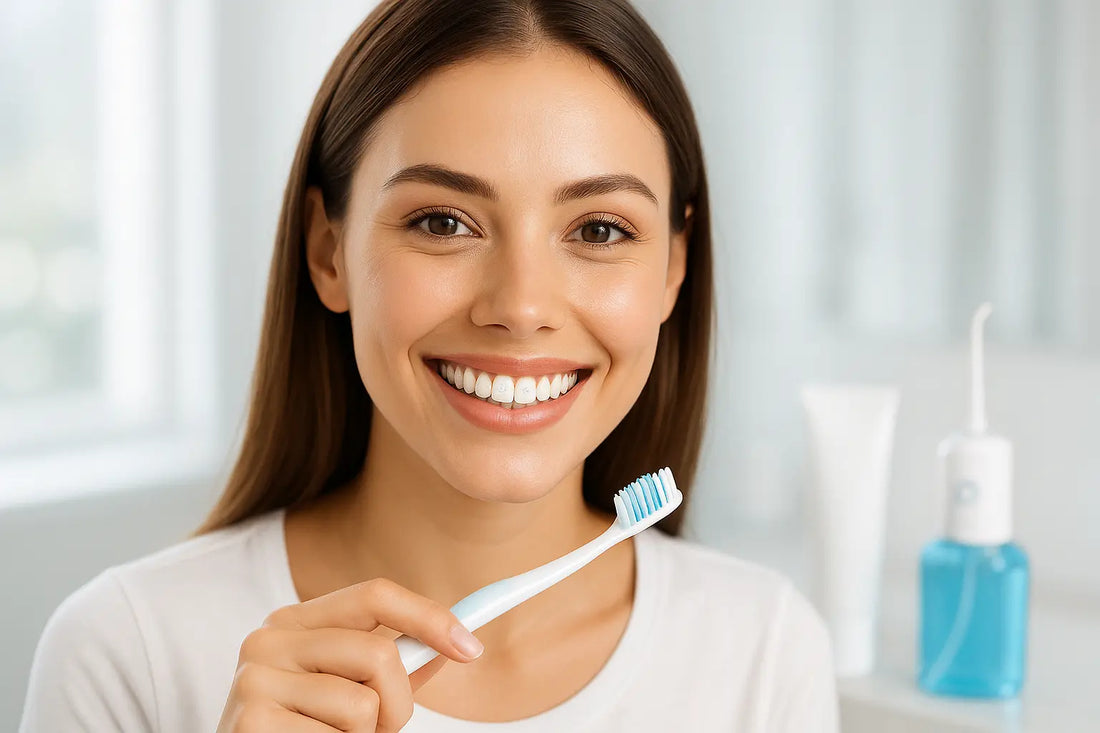
Oral Hygiene with Tooth Gems: A Complete Care Guide
Share
Tooth gems have become an increasingly popular way to add sparkle to your smile, but maintaining proper oral hygiene with these decorative accessories requires special attention and care. This comprehensive guide will walk you through everything you need to know about keeping your teeth and gums healthy while sporting beautiful tooth gems.
What Are Tooth Gems and How Do They Affect Oral Health?
Tooth gems are small decorative crystals, typically made from Swarovski crystals or cubic zirconia, that are bonded to the surface of your teeth using dental adhesive. While these tiny accessories can enhance your smile's aesthetic appeal, they create unique challenges for maintaining optimal oral hygiene.
The primary concern with tooth gems lies in their potential to trap food particles and bacteria around their edges, creating microscopic hiding spots that regular brushing might miss. Understanding how to navigate these challenges is essential for preventing dental complications while enjoying your sparkling smile.
Purchase a dentist-approved Professional Tooth Gem kit Now
Essential Daily Oral Hygiene Routine for Tooth Gem Wearers
Morning Care Protocol
Start your day with a thorough oral hygiene routine that pays special attention to your tooth gems:
Gentle Brushing Technique: Use a soft-bristled toothbrush and fluoride toothpaste. Brush in small, circular motions around each gem, being careful not to apply excessive pressure that could loosen the adhesive. Focus on the edges where the gem meets your tooth surface, as this is where plaque and bacteria commonly accumulate.
Specialized Attention Areas: Pay extra attention to the gum line near your tooth gems and the spaces between your teeth. Food particles and bacteria tend to collect in these areas more readily when decorative elements are present.
Evening Care Routine
Your nighttime oral hygiene routine should be even more thorough:
Extended Brushing Time: Increase your brushing time to at least three minutes, spending additional time gently cleaning around each gem. Use light, methodical strokes to ensure complete plaque removal without compromising the gem's adhesion.
Antimicrobial Mouthwash: Finish with an alcohol-free antimicrobial mouthwash to reach areas your toothbrush might have missed and provide additional protection against bacterial buildup.
Advanced Cleaning Techniques and Tools
Water Flossing for Enhanced Cleaning
Traditional string floss can be challenging to use effectively around tooth gems. Water flossers offer an excellent alternative, providing gentle yet thorough cleaning around these decorative accessories.
Proper Water Flossing Technique: Set your water flosser to a medium pressure setting and direct the stream at a 90-degree angle to your tooth surface. Focus on the junction between the gem and tooth, allowing the pulsating water to dislodge trapped particles without stressing the adhesive bond.
Frequency and Duration: Use your water flosser daily, spending approximately 30 seconds on each gem and the surrounding tooth surface. This targeted approach ensures comprehensive cleaning while maintaining the integrity of your tooth gems.
Interdental Brushes and Specialized Tools
For particularly stubborn buildup around tooth gems, consider incorporating these specialized cleaning tools:
Soft Interdental Brushes: These tiny brushes can navigate around gems more effectively than traditional floss, allowing for precise cleaning of hard-to-reach areas.
Dental Picks with Rubber Tips: Gentle rubber-tipped dental picks can help remove plaque buildup without risking damage to the gem or surrounding enamel.
Purchase a dentist-approved Professional Tooth Gem Now
Professional Dental Care Considerations
Regular Dental Checkups
Maintaining regular dental appointments becomes even more crucial when you have tooth gems. Schedule professional cleanings every three to four months instead of the standard six-month intervals.
Professional Assessment: Your dental hygienist can identify areas where plaque accumulation is occurring and provide targeted cleaning around your gems. They can also assess whether your home care routine is effectively maintaining oral health.
Specialized Cleaning Techniques: Professional dental cleanings for gem wearers often involve ultrasonic scaling at lower power settings and hand instrumentation with specially designed tools that won't damage the decorative elements.
Monitoring for Complications
Be vigilant about potential issues that may arise:
Gum Irritation Signs: Watch for redness, swelling, or bleeding around the gem site, which could indicate inadequate cleaning or allergic reactions to the adhesive materials.
Enamel Health: Regular professional assessments can detect early signs of enamel demineralization around the gem placement area, allowing for prompt intervention if necessary.
Common Mistakes to Avoid
Aggressive Brushing Practices
Many people make the mistake of brushing too vigorously around their tooth gems, thinking this will provide better cleaning. However, excessive force can:
- Loosen the adhesive bond, causing premature gem loss
- Damage the underlying tooth enamel
- Cause gum recession around the gem placement area
- Create microscopic scratches that harbor bacteria
Neglecting Hard-to-Reach Areas
The area immediately behind and around tooth gems requires special attention. Many people focus solely on the visible front surface while neglecting these critical zones where bacteria and plaque commonly accumulate.
Using Inappropriate Cleaning Products
Avoid abrasive toothpastes, harsh mouthwashes containing high alcohol concentrations, and metal dental tools that could scratch or damage your gems. Stick to gentle, gem-safe oral care products recommended by dental professionals.
Purchase a dentist-approved Professional Tooth Gem kit Now
Dietary Considerations and Lifestyle Adjustments
Foods to Approach with Caution
Certain foods can pose challenges for tooth gem maintenance:
Sticky and Chewy Foods: Caramels, taffy, and similar treats can pull at gems and create cleaning challenges. If you consume these foods, rinse thoroughly afterward and clean around your gems promptly.
Highly Acidic Foods and Beverages: Citrus fruits, sodas, and wine can weaken the adhesive bond over time. Consider using a straw for acidic beverages and rinse with water after consumption.
Hard Foods: Be cautious with ice cubes, hard candies, and nuts, which could potentially chip or dislodge gems if bitten directly.
Beneficial Dietary Choices
Incorporate foods that support oral health:
Calcium-Rich Foods: Dairy products, leafy greens, and fortified alternatives help maintain strong tooth enamel around gem placement sites.
Fibrous Fruits and Vegetables: Apples, carrots, and celery can help naturally clean teeth, though be sure to follow up with proper brushing around your gems.
Troubleshooting Common Issues
Managing Plaque Buildup
If you notice increased plaque accumulation around your tooth gems:
- Increase brushing frequency to after every meal
- Use a plaque-revealing tablet to identify problem areas
- Consider switching to an electric toothbrush with gentle pressure sensors
- Consult your dental hygienist for personalized cleaning technique demonstrations
Addressing Gum Sensitivity
Some people experience initial gum sensitivity after gem placement:
- Use a desensitizing toothpaste designed for sensitive teeth
- Rinse with warm salt water twice daily
- Avoid extreme temperature foods and beverages temporarily
- Contact your dental provider if sensitivity persists beyond two weeks
Dealing with Food Impaction
When food particles become trapped around gems:
- Rinse immediately with lukewarm water
- Use gentle water flossing to dislodge particles
- Avoid using sharp objects that could damage the gem or tooth
- Schedule a professional cleaning if impaction becomes a recurring issue
Long-Term Maintenance Strategies
Establishing Sustainable Routines
Success with tooth gem oral hygiene depends on developing consistent, sustainable daily practices:
Time Management: Allocate an extra five to ten minutes daily for thorough cleaning around your gems. This small investment prevents much larger problems down the road.
Product Rotation: Consider alternating between different types of gentle toothpaste and mouthwash to prevent bacterial resistance and maintain optimal oral health.
Regular Reassessment: Evaluate your routine monthly and adjust based on your oral health status and any feedback from dental professionals.
Planning for Gem Replacement
Most tooth gems last between six months to two years, depending on placement, care, and individual factors:
Timing Considerations: Schedule gem replacement during routine dental visits to ensure optimal oral health assessment and professional placement.
Preparation for Removal: When it's time for gem removal, allow your dental professional to handle the process to prevent enamel damage.
Post-Removal Care: After gem removal, you may need a brief adjustment period for your oral hygiene routine as you return to standard tooth care practices.
Professional Recommendations and Best Practices
Choosing the Right Oral Care Products
Select products specifically compatible with dental adhesives and decorative elements:
Toothbrush Selection: Opt for ultra-soft to soft bristled brushes, preferably with rounded bristle tips that won't catch on gem edges.
Toothpaste Considerations: Choose fluoride toothpastes with low abrasivity ratings, avoiding whitening formulas that may contain harsh abrasives.
Mouthwash Options: Select alcohol-free formulations that won't compromise adhesive bonds while providing antimicrobial benefits.
Creating Your Personal Care Plan
Work with your dental team to develop a customized oral hygiene plan that addresses your specific needs:
- Document any areas where plaque tends to accumulate more readily
- Identify the most effective cleaning tools and techniques for your gem placement
- Establish a monitoring schedule for assessing gem condition and oral health status
- Create contingency plans for addressing common issues before they become serious problems
Conclusion: Maintaining Your Sparkling Smile Safely
Proper oral hygiene with tooth gems requires dedication, the right techniques, and appropriate tools, but it's entirely achievable with consistent effort. By following this comprehensive care guide, you can enjoy the aesthetic benefits of your tooth gems while maintaining excellent oral health.
Remember that every person's oral environment is unique, and what works best for others may need adjustment for your specific situation. Regular communication with your dental care team, combined with diligent home care practices, ensures that your tooth gems remain a beautiful and safe addition to your smile.
The key to success lies in viewing tooth gem care not as a burden, but as an extension of your existing oral hygiene routine. With proper attention and care, you can confidently sport your sparkling accessories while maintaining the healthy, beautiful smile that serves as their perfect foundation.
Always consult with qualified dental professionals before getting tooth gems and follow their specific care instructions for optimal results and oral health maintenance.
